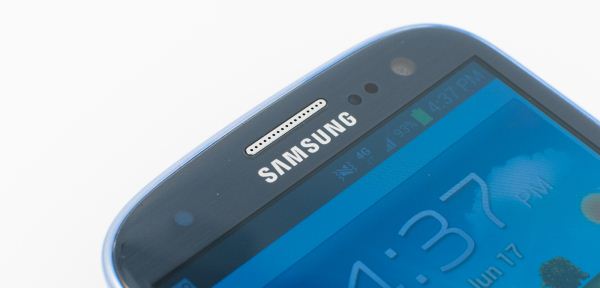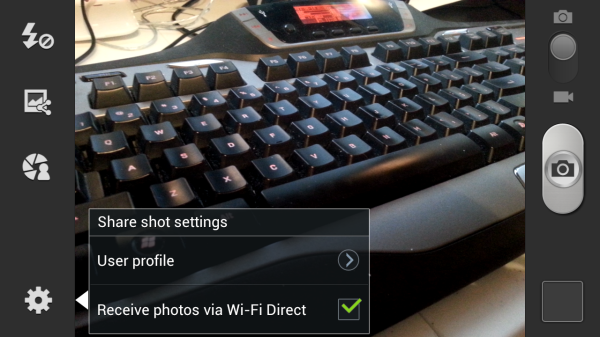Samsung Galaxy S III Review - AT&T and T-Mobile USA Variants
by Brian Klug on June 20, 2012 12:01 AM ESTSamsung didn’t emphasize camera performance very much during its launch event, which surprised me since HTC and Apple have both made steady improvements on the camera experience this generation. That said, the SGS3 does make some iterative improvements of its own in the camera department.
First off, the 8 MP rear facing camera sits behind F/2.6 optics with a relatively wide focal length of 3.7 mm. If you compare to the SGS2’s F/2.7 optics with 4.0 mm focal length, the SGS3 is a fair amount wider, and it’s noticeable when out and about shooting photos. From my digging, I’ve found that both my T-Mobile and AT&T SGS3s contain a S5C73M3 rear camera module - that looks like a Samsung CMOS name to me, but usually Samsung CMOSes start with S5K3 in the 8MP category. This is the same as the International version I’ve seen, though there’s still considerable debate about whether this is a Sony CMOS, but initial reports are that it isn’t the IMX145 from the iPhone 4S. I’ve also seen references to “CML0801” but that doesn’t mean anything to me immediately. Either way, the CMOS is 8 MP with 1.4µm pixels and BSI, images at full resolution are 3264 x 2448.
The front facing camera is a Samsung S5K6A3 CMOS which hasn’t been announced or made formal yet, and as a result I’m not sure about its pixel pitch or format. It is 1.9 MP and square - 1392x1392, which is relatively unique. I wager most users will just use 1280x960 and not know that the 1.9 MP option exists, though it is exposed in the camera UI.
Samsung has made some improvements to the camera UI, and though they’re subtle, they’re nonetheless worth talking about. The camera application does launch speedily, which was one of Samsung’s major points. As I mentioned, the shortcut from home screen (if you enable it) is handy if you don’t want to use up one of the application shortcut spaces.
For SGS2 users, the whole application should be familiar, settings is in the bottom left, and all the icons on the left pane can be changed or customized by long pressing. Tap to focus and expose is still here, and capture speed is nearly instantaneous, just like on the One series.
Shooting modes can be changed from single to burst shot, HDR, and a few other options. HDR combines three exposures like we’ve seen on other platforms, paints a progress bar while it computes (which happens impressively fast) and saves the resulting exposure. Probably one of the cooler shooting modes is share shot, which uses WiFi direct to share photos captured from linked SGS3s to each other. Tapping this brings up the WiFi direct pair prompt, and successive photos get put in a received folder on other devices.
To evaluate still image quality we turn to our usual set of tests, which means the lightbox scene with the lights on and off, and our bench photo locations (numbers 3 - 7 remain). I couldn’t get the test charts and lighting setup due to me moving houses while working on this review (everything is boxed up), but will update when that’s settled. For now we have a decent picture of the SGS3 camera performance, but something I would like to investigate more once I can setup my test charts. Consider the following more of a first impression than really my end thoughts on the SGS3 camera’s performance.
Immediately, you can tell that Samsung has tweaked their camera ISP and disabled the sharpening kernel which used to leave halos around contrasty spatial detail. There’s some loss of high frequency detail to noise reduction which is particularly evident in the lightbox camera’s focus rings and markings, but nothing too inordinate. White balance gives the scene a somewhat purple cast. I have to say that the One X image is sharper, but not by much.
With the lights off, the SGS3 does a great job exposing, and focuses with the scene lit up so it doesn’t miss focus entirely. This is still something I see so many other smartphone cameras not doing, and instead just capturing at infinity focus and hoping for the best. Kudos to Samsung for still doing it the right way.
At the bench location photos, I’m kind of left feeling the same way about the SGS3 camera at first glance. There’s nothing really wrong with it, and it seems to have less distortion (the test chart will tell the objective truth) but it just isn’t as sharp as some of the other cameras I’ve seen. Having a wider field of view is definitely something different, and it’s noticeable over the SGS2.












































107 Comments
View All Comments
ervinshiznit - Wednesday, June 20, 2012 - link
On your SGSII review you say that it had 17 Mbps 1080p video recording, not 15 Mbps as you state in this article.Brian Klug - Wednesday, June 20, 2012 - link
Oh weird, I didn't go look at what I wrote before but went off of what I heard at some point from a Samsung rep said. Fixing...-Brian
vol7ron - Wednesday, June 20, 2012 - link
3rd paragrah threw me off.. "I was sampled"vol7ron - Wednesday, June 20, 2012 - link
err 4thZoomer - Wednesday, June 20, 2012 - link
Do you have any insight on why Samsung chose not to go with a pentaband design like with the SGN? Personally, that's a bit of a deal breaker.Brian Klug - Wednesday, June 20, 2012 - link
The T-Mobile variant is pretty close, it's just missing 900 MHz WCDMA (eg GN is 850, 900, 1700, 1900, 2100 MHz, T-Mo SGS3 is 850, 1700, 1900, 2100). Other than that, the device will work on AT&T and T-Mo, if you can snag an unlocked one.Or are you talking about GT-I9300 (the canonical SGS3)?
-Brian
3DoubleD - Wednesday, June 20, 2012 - link
Can you name the models in the review using their model number. You say SGSIII USA, but there are 4 models total and 3 of those are being carried in the US. Calling it T999, I747, I535, and I9300 is much more straightforward and avoids a lot of confusion. Also, if Samsung doesn't want to be embarassed by their terrible naming, they can pick better model names.Thanks for the speedy review. I didn't expect this review for at least a few more weeks. Thanks a million!
Brian Klug - Monday, June 25, 2012 - link
Sure:AT&T: SGH-I747
T-Mobile: SGH-T999
-Brian
Zoomer - Wednesday, June 20, 2012 - link
Are you certain that it supports Band I when it's doing AWS? It seems to be a common theme among other phones.sunbear - Saturday, June 30, 2012 - link
If I can unlock a tmobile device, would it work on AT&T's LTE, or would it be limited to to HSPA+?